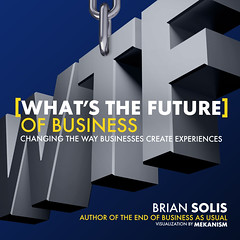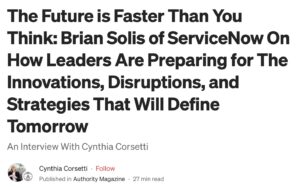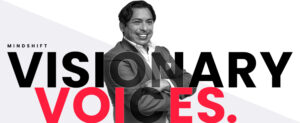Disruption!
It’s everywhere. I live in Silicon Valley where many say that the terms disrupt and disruption have become buzzwords. Pundits believe that the word is losing its promise and impact through the acts and examples of entrepreneurs and businesses that misuse the word to describe intentions rather than associating it with a desired or natural effect.
In some of the startup meetings I attend for example, digital disruption is actually a stated business objective. Instead of “killing it” or “crushing it” many businesses are aiming now to disrupt it!
Kidding aside, disruption is more than a buzzword of course. It is a term that is becoming an important part of everyday business to describe what is happening to and around markets and ultimately companies everywhere. While it may be a genuine goal, disruption is the act of disturbing or interrupting the norm and its effect is measured by the the following series of events that unfold.
Like it or not, disruption is a natural part of life. I refer to this phenomenon as Digital Darwinism, when society and technology evolve faster than the ability to adapt. Every so often something comes along and completely upsets the norm. And this is only accelerating. Either you’re disrupting or you’re at risk of getting disrupted.
Continuing the Digital Darwinism metaphor, businesses, like nature itself, are open to natural selection. One of the three common forms of natural selection (including directional and stabilizing selection) that I’d like to explore is that of disruptive selection, which selects against the mean of the population. Adapting the definition to suit the purpose of this discussion, disruptive selection singles out average businesses in any given population making room for speciation, the formation of new and distinct species in the inevitable course of evolution.
In my research on disruptive selection, I found several references to London’s peppered moths. H.B.D. Kettlewell, an English physician set out to study the unexplained color variations of the peppered moth in the 1950s. Kettlewell set out to better understand why in the industrialized areas of Britain, the peppered moth population evolved from light gray-colored individuals to that of primarily of dark gray species. In rural areas, the peppered moths were predominately light in color. Kettlewell learned that darker moths survived predators in the industrial areas by blending in to polluted environments. The lighter moths stood out and were seen easily by predators. In rural areas, the opposite would occur.
In the realm of digital disruption, disruptive selection opens the door to creative destruction, which is set to unleash up every industry imaginable. As Joseph Schumpeter noted in, “Capitalism, Socialism and Democracy” published in 1942, creative destruction is the process of industrial mutation that incessantly revolutionizes the economic structure from within, incessantly destroying the old one, incessantly creating a new one. Said another way, there’s always going to be instances where new kills old or the the old evolves into something new.
Let’s take Uber for example as a form of disruptive selection. Who here loves taking taxis? I’m often in San Francisco and New York and the experience that I have is, well, poor, which is kind. Cars don’t stop to pick you up. When they do, cars are often dirty, drivers are frequently less than pleasant, and the goal of getting from point A to B is generally by way of creative way points.
As a result, I’m a big fan of Uber as is anyone who uses the service.
For those unaware of Uber, it was founded in 2009 by Garrett Camp, Travis Kalanick and Oscar Salazar as an on-demand mobile platform that connects passengers to available drivers. The app shows passengers available cars, the distance/time to them, an estimated price based on their destination and an integrated payment system so that you can simply step out of the vehicle rather than doing the oft uncomfortable dance of remittance. More importantly, Uber introduces a human touch, giving passengers the ability to rate drives and also learn more about each driver and the experiences other Uber users have shared for each. This is important because it introduces a shift in the value proposition.
Each time I get into an Uber car, I interview the driver to learn more about why they use Uber. The story is often the same. As you would guess, money is part of the equation, but so is service. Each driver has their own process of greeting passengers and ensuring that their ride is clean, pleasant and personalized. Those who don’t get it…don’t get it and it’s clear in their reviews. PASS!
At a minimum though, Uber offers black car or luxury car operators to expand their customer base when they’re in between jobs. The price is often comparable to that of a standard cab and as you can imagine, taxi operators are not in love with Uber. Essentially, Uber is disrupting the taxi industry and this has regulators up in arms as they flail to protect their way of life.
Rather than fixing the taxi industry’s problems or setting out to improve passenger experiences, regulators and officials instead cry foul and attempt to block Uber in each city it introduces. WTF!? If anything, that’s a response worthy of Digital Darwinism and a strong example of disruptive selection in action. If you have a choice, the decision is easy. And over time, unless the taxi industry innovates to compete, companies such as Uber and Sidecar will at come point become the norm. To date, Uber is now in 29 cities internationally and was recently awarded Fast Company’s “2013 Most Innovative Company in Mobile.”
Disruption eventually gives way to models and templates for others to follow. Eventually however, disruption evolves into business as usual until it is disrupted again through a process of disruptive selection. Reacting to disruption may already be too late. Setting out to improve experiences and outcomes and finding innovative ways to do so is your only answer. And, this is something that becomes part of everyday business.
Setting out to disrupt markets is commendable, but to compete for the future takes more than intent to disrupt, it takes vision to see what others cannot and perseverance to do what others cannot or will not. The best investment you can make in business is the quality and experience of your product for it is the experience that people will document and share. In a connected economy, those shared experiences become the trusted leverage other consumers seek to make informed decisions.
Every threat has its antagonist. Disruption is only thwarted, or also fueled by, innovation.
#InnovateorDie
The story continues…
Connect with me: Twitter | LinkedIn | Facebook | Google+ |Youtube | Instagram
Image Credit: Shutterstock







Disruption is much more tan a buzzword, its a state of mind when thinking..
When talking about Disruption there is a fundamental book to read.
Disruption: Overturning Conventions and Shaking Up the
Marketplace. From Jean Marie Dru
Thank you.
Enriching thoughts about disruption briansolis
If I may add to this discussion, I would say that what ‘disruptive businesses/opportunities’ need is a solid and clear understanding of the ‘levers’ that lead to the tipping point. Having a firm grasp of the business landscape (all stakeholders/”special interests”) via a blueprint will help to create compelling micro-experiences for those special interests to help them see what’s in it for them. A blueprint will also highlight opportunities when any of these levers try to work against you.
…on a side note, usurp could be the next buzzword 😉
#usurp
#uSirB (as in B for Brian ;))
Very much Informative & helpful Article. Thanks for sharing with us.
Creativity and innovation are incredibly important skills to master moving forward in the times we’re living in.
If you don’t master these skills, you’ll find it damn near impossible to keep up with the people you compete with. And this isn’t optional just as physical training isn’t optional for an Olympian track runner.
The speed at which change is unfolding is constantly asking us to adapt, innovate and create and without the ability to create and innovate, you get left behind by all the people who can and become an embarrassment as you cry to your mommy (government/regulators) that Uber cab isn’t playing fair.
But if you master these abilities you take the steering wheel and you direct yourself towards success and accomplishment amidst the top of the hill where the other innovators and achievers dwell.
While taking notes on a course titled, “How To Be Creative and Innovative” which was assembled by Eben Pagan, I was exposed to a set of 10 tools will that help you stay fresh and useful and significant in all the important areas of your life – not just business.
What you speak of in this post Brian reminds me of thirteen of mankind’s most creative innovations.
There is a commonality between all of them. See if you can figure it out . . .
First: The paintings in France’s Chauvet Cave, which contains the oldest human-painted
images found on Earth.
These enchanting paintings depict images of animals that existed back then using colored substances with techniques that still haven’t been identified, and succeeded in recreating real forms i.e. realistic drawing.
Second: The Greeks making the introduction of the idea of using the mind to think for yourself rather than just receiving what everyone else thinks – deciding for yourself whether something is true or not, good or not, beautiful or not.
Third: Eratosthenes, another Greek, who invented the discipline of geography as we understand it today – i.e. the world being round. He not only surmised that the world was round, but he also determined its circumference very accurately – 2,200 years ago.
And he did this by measuring the shadows of two different sticks at two different places on the same time on the same day on a solstice. This is incredible.
Fourth: Galileo’s discovery that earth wasn’t the center of the universe with a telescope pointed towards the sky was a game changer such that it almost got him killed for turning the authorities’ preconceived beliefs on their head.
Fifth: Isaac Newton discovering white light made up the whole spectrum of colors.
Sixth: Michael Faraday, the man who invented the motor.
Seventh: Charles Darwin, the man who pioneered adaptation and selection in nature which is
referred to now as natural selection – the course of evolution.
Eighth: The Wright Brothers, the men who built the first fully functional airplane.
Ninth: Henry Ford’s invention of the assembly line which was a gigantic breakthrough for
manufacturing which was adapted by him modeling a meat processing line.
Tenth: Einstein and his shifting from time being a fixed point, to the speed of light being the
fixed point.
Eleventh: Dr. Roy Walford who developed a diet for a human that allowed them to potentially live 120 years on only half the food most people eat.
Twelfth: The Google Guys – Larry and Sergey who pioneered the importance of what sites other people thought were useful and figuring out a model that brought up the most popular/relevant sites when terms were searched for so that people could find the information they wanted to, for free.
Thirteenth: Adam Curtis famous for his documentary – The Century of The Self that revealed how corporate America and politicians are using the trend of people becoming self aware and interested in expressing themselves through consumption to control the masses.
What Do All Of These Innovations Have In Common With Each Other?
They’ve all disrupted large population’s beliefs, ways of doing business and ways of living their lives.
Disruption, when embraced as the norm, as the result of considering history, is a tremendous liberator for those willing to create and innovate. And it serves as a death sentence to those who refuse to create and innovate.
And what’s cool is that we all have a choice – to think and then act, or not to think and whine about what “should be” rather than doing something with what is.
Thank you Brian for reminding of such an important lesson. 🙂
Disruption is not a buzzword, it is the world we are living in right now. I am in legal and we are seeing disruption. Thanks for this thought-provoking read. Have shared on my channels. Great post as always.
love it!
Hi Brian. Check out Reinvent Law. Really good disruptive stuff from Daniel Katz. Think you will find it interesting.
Creative destruction is the pattern by which innovation occurs; this has been the case for as long as product offerings have existed as concept. I am often surprised how easily business (and its leadership) are distracted by confirmation bias in this area. Great read; thank you for writing it!
Thank you for the comment!